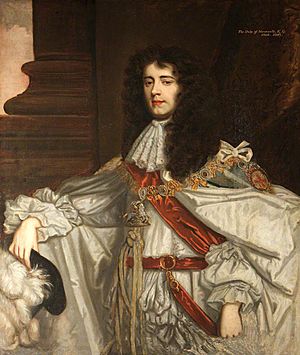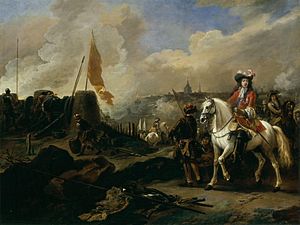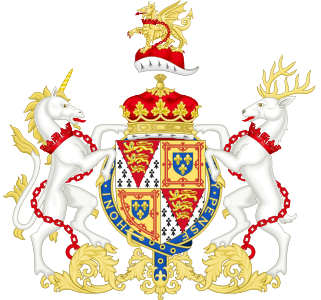James Scott, 1st Duke of Monmouth facts for kids
James Scott, 1st Duke of Monmouth, 1st Duke of Buccleuch (born 9 April 1649 – died 15 July 1685) was an English nobleman and military leader. He was born in Rotterdam, Netherlands. His original names were James Crofts or James Fitzroy. He was the eldest son of King Charles II of England and his mistress, Lucy Walter.
The Duke of Monmouth fought in the Second and Third Anglo-Dutch Wars. He also led English troops in the Franco-Dutch War. In 1685, he led a rebellion known as the Monmouth Rebellion. He tried to take the throne from his uncle, King James II and VII. Monmouth was a Protestant, and James was a Roman Catholic. Monmouth hoped his Protestant faith and his link to Charles II would help him. However, the rebellion failed. Monmouth was executed for treason on 15 July 1685.
Quick facts for kids
The Duke of Monmouth
|
|
|---|---|

Portrait by Peter Lely, c. 1680
|
|
| Born | 9 April 1649 Rotterdam, Dutch Republic |
| Died | 15 July 1685 (aged 36) Great Tower Hill, Tower of London, Liberties of the Tower, England |
| Nationality | English |
| Spouse(s) | |
| Issue | 9, including: |
| Parents | |
| Military career | |
| Allegiance | Kingdom of England |
| Service/ |
English Army |
| Years of service | 1665–1685 |
| Rank | General |
| Battles/wars | |
Contents
Biography
Early Life and Family
Charles, Prince of Wales (who later became King Charles II), moved to The Hague in 1648. This was during the Second English Civil War. His sister Mary and her husband William II, Prince of Orange, lived there. Charles chose the Netherlands because he thought he could get more support for his father, King Charles I.
In the summer of 1648, Prince Charles met Lucy Walter. Their son, James, was born in Rotterdam, Netherlands, on 9 April 1649. James spent his early childhood in Schiedam.
James had a younger sister or half-sister named Mary Crofts. Mary later married William Sarsfield.
James was born outside of marriage. This meant he could not become king of England or Scotland. King Charles II stated in writing that he had only ever been married to his queen, Catherine of Braganza.
In March 1658, young James was taken to Paris. He was placed in the care of William Crofts, whose last name he then used. He briefly went to school in Familly.
Becoming a Leader
On 14 February 1663, James was made Duke of Monmouth. He also received the titles Earl of Doncaster and Baron Scott of Tynedale. He was almost 14 years old at this time. On 28 March 1663, he became a Knight of the Garter.
On 20 April 1663, just after his 14th birthday, James married Anne Scott. She was the 4th Countess of Buccleuch and a wealthy heiress. He took her last name, Scott, after they married. The day after their wedding, they were made Duke and Duchess of Buccleuch.
The Duke of Monmouth was very popular, especially because he was a Protestant. The King's official heir, James, Duke of York, had become a Roman Catholic. This made many people worried.
In 1665, at age 16, Monmouth served in the English navy. He fought under his uncle, the Duke of York, in the Second Anglo-Dutch War. In June 1666, he became a cavalry captain. In 1668, he became a colonel in the King's own cavalry unit.
When the Third Anglo-Dutch War began in 1672, Monmouth led a group of 6,000 English and Scottish soldiers. They fought as part of the French army. In 1673, especially at the Siege of Maastricht, Monmouth became known as a very skilled soldier.
In 1674, Monmouth became the leader of Cambridge University. He also became Master of the Horse. King Charles II ordered that all military commands should go to Monmouth first. This gave him control over the army. He was in charge of moving troops and stopping riots. In March 1677, he also became Lord Lieutenant of Staffordshire.
Claim to the Throne
In 1678, Monmouth led the Anglo-Dutch brigade. They were now fighting for the Dutch against the French. He showed great bravery at the Battle of Saint-Denis in August 1678. This made his reputation even stronger.
The next year, he returned to Britain. He led a small army to stop a rebellion by Scottish Covenanters. Even though he was greatly outnumbered, he defeated the rebels at the Battle of Bothwell Bridge on 22 June 1679.
The Rebellion
As Monmouth's popularity grew, he had to go into exile in the Netherlands in September 1679. In 1683, a plan to kill both King Charles II and his brother James was discovered. This was called the Rye House Plot. Monmouth was seen as a part of this plot.
When King Charles II died in February 1685, Monmouth led the Monmouth Rebellion. He landed in Lyme Regis, Dorset, in early June 1685. He wanted to take the throne from his uncle, James II. Monmouth published a statement saying he was the rightful king. King James II ordered that anyone publishing or sharing this paper be arrested.
Monmouth declared himself king in several towns. These included Axminster, Chard, Ilminster, and Taunton. The two armies met at the Battle of Sedgemoor on 6 July 1685. This was the last big battle fought on open ground in England. Monmouth's army was not as strong as the King's regular army. They were completely defeated.
Capture and Execution
After the battle, a reward of £5,000 was offered for Monmouth's capture. On 8 July 1685, he was found and arrested near Ringwood in Hampshire. He was found hiding in a field of peas.
Monmouth had changed clothes with a shepherd. Dogs were used to track his scent. He dropped his gold snuff box, which was full of gold coins, in a pea field.
Monmouth was found hiding in a ditch under an ash tree. He was covered with ferns and brambles. He was very hungry and tired, having only eaten raw peas. He could not stand up. His appearance had changed a lot.
Monmouth was taken to Holt Lodge. A local judge asked him what he would do if he were set free. Monmouth replied that if he got his horse and weapons back, he could ride through the army and they would never catch him again. The judge then ordered him to be taken to London.
Parliament passed a special law against Monmouth. This law declared him guilty of high treason without a trial.
The King allowed Monmouth to meet him, which was unusual. However, the King had no plan to forgive him. Monmouth begged for mercy and even offered to become Catholic, but it did not help. The King was not impressed and told him to prepare to die.
Monmouth was executed by Jack Ketch on 15 July 1685, at Tower Hill. Before his execution, religious leaders visited him. They refused to give him a final blessing because he would not admit his rebellion or his relationship with Lady Wentworth were wrong.
It is said that Monmouth asked Ketch to finish him in one blow. However, Ketch struggled and hit him many times with the axe. This shocked the people watching. Some say a knife was used to finally cut off his head. Sources say it took between five and eight blows.
Monmouth was buried in the Church of St Peter ad Vincula in the Tower of London. His title of Duke was taken away. However, his other titles, Earl of Doncaster and Baron Scott of Tindale, were given back to his grandson in 1743.
Popular Stories
There is a story that a portrait of Monmouth was painted after his execution. The story says that people realized there was no official painting of him. So, his body was dug up, his head was sewn back on, and he was painted. However, there are already several portraits of Monmouth from before his death.
Another story is that Monmouth was the famous "Man in the Iron Mask." This theory suggests someone else was executed in his place. Then, James II sent Monmouth to France to be held by his cousin, King Louis XIV.
Arms
James Scott's first coat of arms was given to him in 1663. This was when he became Duke of Monmouth. It showed a red triangle with three golden lions on a white background. It also had a blue shield with three golden lilies, surrounded by a red border. This design looked very similar to the Royal Arms. Many people complained because it did not show that he was born outside of marriage. This led to rumors that King Charles might try to make James a legitimate heir.
Four years later, after James got married, a new design was given to him. This new design showed the Royal Arms of King Charles II. However, it had a silver diagonal stripe across it to show he was not a legitimate heir. A small shield with the Scott family crest was added on top. This showed the importance of his marriage to Anne Scott. The crest and supporters from his earlier arms were kept.
Children
James had six children with his wife, Anne Scott, 1st Duchess of Buccleuch:
- Charles Scott, Earl of Doncaster (born 1672 – died 1674)
- James Scott, Earl of Dalkeith (born 1674 – died 1705). He married Henrietta Hyde. They were the parents of Francis Scott, 2nd Duke of Buccleuch.
- Lady Anne Scott (born 1675 – died 1685)
- Henry Scott, 1st Earl of Deloraine (born 1676 – died 1730)
- Francis Scott (died as a baby in 1679)
- Lady Charlotte Scott (died as a baby in 1683)
He also had three children with his mistress, Eleanor Needham:
- James Crofts (died 1732), who became a major-general in the Army.
- Henrietta Crofts (born around 1682 – died 1730). She married Charles Paulet, 2nd Duke of Bolton.
- Isabel Crofts (died young)
Family tree
| Edward Hyde 1609–1674 |
Charles I 1600–1649 |
||||||||||||||||||||||||||||||||||||||||||||
| Henry Hyde 1638–1709 |
Anne Hyde 1637–1671 |
James II & VII 1633–1701 |
Mary of Modena 1658–1718 |
Mary 1631–1660 |
Charles II 1630–1685 |
||||||||||||||||||||||||||||||||||||||||
| James the old pretender 1688–1766 |
|||||||||||||||||||||||||||||||||||||||||||||
| Anne 1665–1714 |
Mary II 1662–1694 |
William III & II 1650–1702 |
(illegitimate) James Scott 1649–1685 |
||||||||||||||||||||||||||||||||||||||||||
See also
 In Spanish: James Scott, I duque de Monmouth para niños
In Spanish: James Scott, I duque de Monmouth para niños






